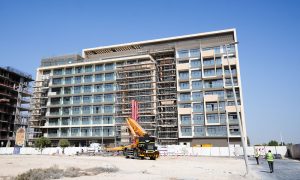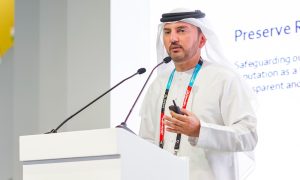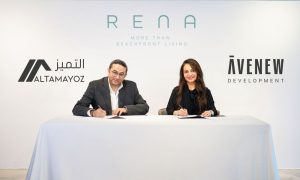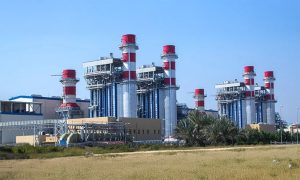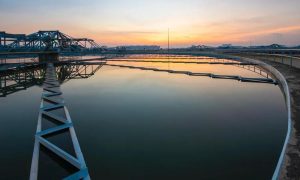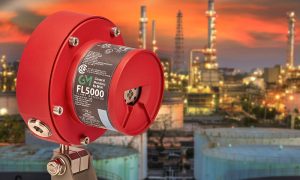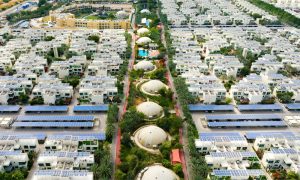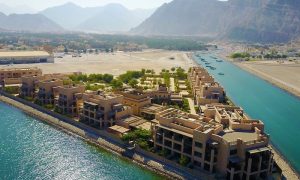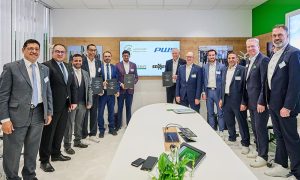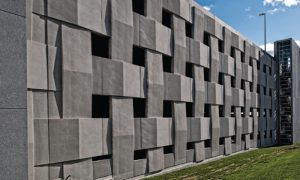Taking the Dubai elevator business to the next level
Vertical transportation experts explain the new technologies in lift design and the challenges the industry faces

Over the last 10 years, Dubai has become home to 18 of the tallest towers in the world. The Burj Khalifa holds the record for the tallest building in the world at 828 metres; the Princess Tower is the world’s tallest residential skyscraper at 414m; and others like 23 Marina, Elite Residence and the Almas towers make up quite an impressive skyline. But building these iron mammoths requires extensive planning and engineering.
One of the most critical issues to be addressed involves implementing the right vertical transportation system. With skyscrapers touching new heights every few years, vertical transportation has also evolved. In fact, experts like Anand Sivan, managing director at Barker Mohandas Vertical Transportation Consultants in Dubai, believe that advancements in vertical transportation technology have played a key role in allowing architects to dream bigger.
READ MORE: Elevator safety code ‘not always followed in Dubai’
“Vertical transportation has evolved in leaps and bounds over the decades. Simple low-rise buildings of the past have made way for super tall structures, and I believe that the developments that we have seen in elevator technology have enabled designers and architects to go taller.
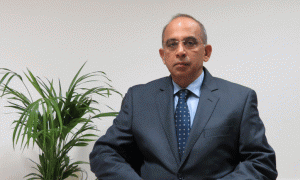
Anand Sivan
“When buildings turned taller, architects added more elevators to transport people within a given time. This demanded increased core space, which decreased the amount of leasable area. Sky lobbies and double-deck elevators then helped address such issues and resulted in better and more efficient transportation. In the words of Barker Mohandas’s co-founder and principal consultant Rick Barker, ‘Sky lobbies naturally separate the types of occupancy in a tall mixed-use tower, and allow some lift hoistways to be located above other lift hoistways in most tall towers.’”
The advent of sky lobbies was only the beginning for vertical transportation technology. Syed Shamsulhaq, general manager, Elevator Division at Al-Futtaim Engineering, points out that the development of geared and gearless electric elevator systems in the 20th century was another factor that aided vertical transportation for taller buildings.
Other things like multi-speed motors improved passenger ride comfort and landing accuracy, while the introduction of double deck elevators resulted in better space utilisation and people movement. In parallel, things like escalators and moving walks technology evolved as well.
READ MORE: Elevator safety code ‘not always followed in Dubai’
Agreeing, Richard Roberts, business development director at Lerch Bates, specifically highlights developments in single deck and double deck lifts.
“Several years ago, ThyssenKrupp released the TWIN, which is an ‘uncoupled’ double deck which allows two zones to be served by two independent lifts sharing the same guide rails generally at different speeds. Now they’ve come up with a multi-car solution called MULTI, where there are multiple cabins within the same shaft without traction ropes and using a linear drive.
“Even KONE has introduced interesting technology like the UltraRope. Here they’ve moved away from the traditional steel rope to carbon fibre, which reduces the weight of the rope and allows for longer travel distance. Other companies are also developing alternate suspension technologies.”
In terms of vertical transportation technology that has been a game-changer in the Middle East, Shamsulhaq says that the introduction of machine room less (MRL) elevators in the region, particularly in the low-rise and villa segments, has made a big difference, enabling private owners to save on construction of traditional machine rooms and associated costs.
In many applications, they have replaced hydraulic elevators. Sivan believes that it’s not just the introduction of new technology that makes a difference; applying better techniques to existing solutions matters as well.
READ MORE: Elevator safety code ‘not always followed in Dubai’
Highlighting the way calls are allocated to elevators, he says that while standard destination dispatching currently offered by lift companies comes with the promise of saving time for the users, it is not always so.
For example, Sivan says that while it boosts the morning predominantly up-directional traffic in an office building, differences are stark during the more intense lunch peak time when people are travelling in both up and down directions simultaneously.
Sivan cautions, “Destination dispatching, if not carefully applied, could worsen long waits. We should remember that the time waiting for the lift to arrive in answer to a registered call is a more important metric than time spent in the lift cab.”
At Barker Mohandas USA, Rick Barker has developed techniques to improve that. One is a hybrid destination dispatching where essentially existing technology is used but designed with improved techniques. “It is not just handling passenger traffic, there are other engineering issues as well. For example, a tall building tends to sway with the wind and there are components in the lift shaft such as ropes and cables that move as well. Therefore all of these have to be engineered in a specific way and we have to foresee problems and suggest solutions to those at the design stages itself.”
Since the right vertical transportation solution for a super tall building is extremely important, how should these experts collaborate with architects and designers? To start with, Roberts says that it is key to interact not only with the architect but also with the structural and MEP consultants. He also believes that experienced vertical transportation consultants wear multiple hats and need to have a thorough understanding of their field of expertise.
“First of all, I was taught how to perform manual calculations. You need to understand if a simulation feels and looks correct, and if not, you need to delve into an analysis and review your inputs. Secondly, ask multiple questions to understand the owner and architect’s wants, needs and vision for the project. Third, geography has implications; and lastly, how does the end user interact within the building?”
READ MORE: Elevator safety code ‘not always followed in Dubai’
Shamsulhaq and Sivan stress the need for vertical transportation (VT) experts to be involved with the project right from the initial concept to the design or tender stage. Shamsulhaq explains that by understanding the usage of a building, VT experts carry out a traffic study of the units to ensure a minimum passenger handling time. “A traffic study considers the following aspects: number of floors, population per floor, type of building, capacity and speed. Having arrived at a suitable conclusion for each, designers can incorporate shaft sizes into the building plans.
“With the intent of effective utilisation of space, VT experts may advise on various options of operation, such as group operation, zoning, MRL solution, destination dispatch system, double deck elevators, etc. Also, a suitable combination of elevators and escalators would be required for efficient people movement.”
While things like destination dispatching and ensuring that people wait no longer than 90 to 120 seconds for an elevator is important, there are other crucial considerations, such as fire and life safety.
Shamsulhaq says that buildings are generally designed with two recall floors – the main lobby and an alternate floor – for lifts in the event of a fire. Therefore, most lifts are equipped with the fireman operation: upon detection of a fire, the lift travels directly to the main floor. In the event of fire on the main floor, the lift is recalled to the alternate floor, and the passengers use the emergency exit routes to leave the building.
“Additionally, operation of lifts in the event of power failure is also available. In this case, all the lifts will travel to the main floor one at a time, thereby conserving energy, and one or more pre-designated lifts will operate under the generator supply.
“In case of rescuing a trapped passenger, a manual rescue operation can be carried out. Alternatively, lifts can be designed to have side exit doors, whereby passengers can move from a lift to its adjacent lift inside the shaft. This is generally seen where there is a blind shaft, which is a lift shaft with a large number of floors but without lift entrances or stops.”
Adding to this, Sivan stresses the necessity of having occupant evacuation elevators in place. Citing the tragedy in 2001 at the World Trade Center in New York, he says there is much to be learnt from it. “If you look at the collapse of the World Trade Center, everyone who escaped the buildings were the ones that used the elevators. For a long time we’ve all seen the sign that says ‘Do Not Use Elevators in Case of Fire’ – this is because these lifts aren’t designed for reliable use when there is a fire. We can expect to see increasing requirements for occupant evacuation elevators soon. In fact the US elevator codes already require it.”
Besides this, there are other considerations, such as resistance to water used during firefighting and seismic countermeasures. Sivan says that strangely, while the European code followed by Dubai Municipality demands water protection (EN81-72), its non-implementation is more the norm than the exception, unfortunately.
“I remember scanning the newspapers when a fire broke out in a tall building in Dubai Marina. What stood out was that while the firefighting elevators were used, water was reported coming down the shafts and the lifts were stopping, because these fire-fighters’ lifts were not designed with water protection.
“What is unacceptable is that the code already demands water protection, so this should not have happened. The client may be unaware of this, but the lift industry cannot sell lifts without including the water protection requirements already present in the governing codes.”
Even in terms of seismic engineering, while the European codes only introduced it fairly recently in November 2013, Sivan believes that it is largely still not used in the Middle East.
“For a long time, lift consultants and lift manufacturers did not educate the client about the requirement for fire-fighters’ elevators that included water protection, and about elevators requiring seismic safety. They took shelter under the fact that the European lift code earlier never had a seismic section.
“The Dubai Municipality specifies the European code EN-81 as a basis for product sourcing, installation, etc. In the event of a significant earthquake in Dubai, only a few elevators will be safe for tall buildings, except for lifts that have been specifically designed with adequate seismic countermeasures. Also, the seismic section of the EN-81 Code bases itself on a structural engineering code (Eurocode 8) which, however, is not the basis for most structural engineering design for buildings in the region. That is why we always recommend the application of the seismic section of the US elevator codes to make the design robust. Unfortunately, this is resisted by some lift manufacturers.”
Roberts says vertical transportation experts still face quite a few challenges, such as reducing the number of lift cores to serve the building while still meeting performance criteria. “Sometimes there are height restrictions, and experts need to figure out where to locate the machine room. Adding to this is not having a machine room at the top floor to reduce the exposure of the mechanic performing his maintenance.”
Shamsulhaq says the availability of adequate lift shaft sizes according to the usage of the building is another issue. This is because the developer wants to increase his tenant space, but at the same time does not want to compromise on passenger handling capacity.
Despite all these factors, the vertical transportation industry has an exciting future with buildings getting taller. Roberts believes we will see more sky lobbies and stacking of lifts, and more breakthroughs such as the ThyssenKrupp TWIN and MULTI, and the KONE UltraRope.
Sharing his concluding thoughts, Shamsulhaq too sees many breakthroughs. “There has been a lot of research done in this area in terms of material technology and control systems, and we will definitely see improved energy efficiency and sustainability of the elevator systems. One thing is for certain, all this ongoing development, when completed, will surely have a great impact on the elevator business and vertical transportation industry as a whole.”
READ MORE: Elevator safety code ‘not always followed in Dubai’
